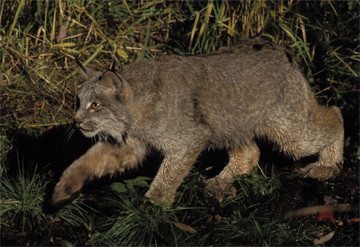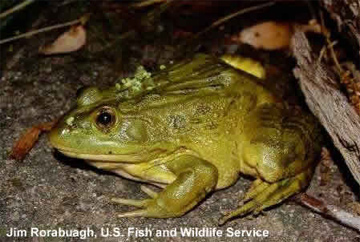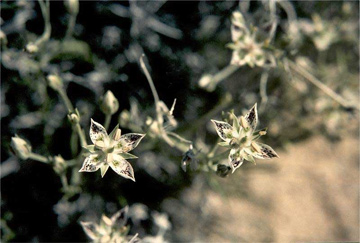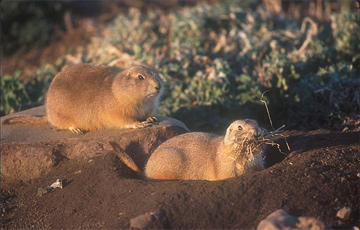Group files for ESA protection of 681 species in 12 states
Group files for ESA protection of 681 species in 12 states:
An Interview with Dr. Nicole Rosmarino
Jeremy Hance, mongabay.com
May 21, 2008
|
|
On March 19th WildEarth Guardians filed a lawsuit to place 681 species under the Endangered Species Act. Dr. Nicole Rosmarino, wildlife program director for the environmental group, says These 681 species represent species in only 12 states, include no subspecies, and are only the “most imperiled” of the United State’s threatened species. Rosmarino estimates that in total there are 6,000-9,000 endangered species in the United States today.
Mongabay.com recently caught up with Dr. Rosmarino regarding this landmark lawsuit and the reasoning for it. “After years of submitting lengthy petitions for single-species that clearly demonstrated the species were in trouble and needed protection from the Endangered Species Act, and then seeing those petitions being denied for political reasons, we decided to try something new,” Rosmarino said.
 Dr. Nicole Rosmarino |
The impetus for the lawsuit essentially comes down to the current administration’s unwillingness to add species to the Endangered Species Act, no matter how close to extinction they are. Rosmarino says that the Bush Administration is “philosophically opposed to the Endangered Species Act” and alleges that they have intentionally hired personnel who have a record of fighting the Endangered Species Act at every possible turn to ‘protect’ these species. Furthermore, she states that the administration has rewritten the Act in order to provide less protection for species. For example, Rosmarino believes that the recent decision to deny wolverines protection in U.S. because there is a viable population in Canada “is faulty logic and an illegal rewrite of the ESA”.
Rosmarino does see hope in the future. She believes that the next administration will be more open listing species under the ESA, stating “I think we are at rock-bottom on endangered species protection”. But she sees trouble for next administration considering the backlog of species needing protection after eight years of neglect. “The next administration… will have a big mess to clean up after Bush departs. What we need is an administration that is willing to really tackle this problem, and we need more appropriations from Congress to increase the pace of listings.”
For Rosmarino, these 681 species are only the first step in protecting America’s wildlife from a mass-extinction.
Mongabay: What made your organization decide to go from fighting single-species listings to filing a suit including a stunning total of 681 critically imperiled or imperiled species?
Nicole Rosmarino: After years of submitting lengthy petitions for single-species that clearly demonstrated the species were in trouble and needed protection from the Endangered Species Act (ESA), and then seeing those petitions being denied for political reasons, we decided to try something new. We took a source that the US Fish and Wildlife Service (FWS) considers authoritative – NatureServe, an international network of biological inventories – and we selected the most imperiled species in the NatureServe database. We were conservative in our choices: we only petitioned for full species (although subspecies can also be protected under the ESA), and we only petitioned for species in two FWS regions, the Southwest and Mountain-Prairie regions. We filed the first petition, for 475 species in the Southwest Region (NM, AZ, TX, and OK) in June 2007. We followed that up with the Mountain-Prairie (UT, CO, WY, MT, ND, SD, KS, NE) petition for 206 species in July 2007.
 Lynx (credit Erwin and Peggy Bauer) |
Our mass listing petitions were motivated by the knowledge that we are in the midst of a massive extinction crisis, with global extinction rates 1,000 times higher than the natural evolutionary extinction rate. We have one of the best tools in the world to fight the unnatural pace of extinction: the Endangered Species Act.Yet, according to our research, 80% of the imperiled species in the US are not listed under the ESA. While 6,000-9,000 species in the U.S. are at risk, only about 1,350 U.S. species are currently listed (protected) under the ESA. We seek to close the gap between the number of species scientists recognize as endangered and the number of species that the government considers endangered.
In short, the ESA works, many species urgently need to board the legal Ark it provides, and we aim to help board those passengers. Our petition includes butterflies, moths, fishes, salamanders, oaks, daisies, grasses, mussels, springsnails, and many other strands in the rich tapestry of life in the western U.S. Some of these life forms exist in only one location, and others haven’t been seen for decades. They urgently need the nation’s Ark.
Mongabay: If you win the case will the species be automatically listed under the ESA, or will they be evaluated one-by-one?
 Chihuahua Scurfpea (credit U.S. Bureau of Land Management) |
Nicole Rosmarino: Our mass listing lawsuit challenges the failure of FWS to make a finding on our 2007 petitions. The first step would be a finding on whether our petitions contain substantial information warranting full status reviews for these species. One scenario is that those subsequent status reviews would result in proposals for listing. While FWS could issue the initial finding (on the substantial information standard) for all species at once, they might also group species (e.g., all species occurring in Big Bend National Park or all the southwestern springsnails) that face similar threats. Or they might look at them one by one. How they issue findings is up to FWS – what we are challenging is their failure to issue any findings on our petitions.
Mongabay: Recently, the Bush administration decided not to list the wolverine under the ESA because it has a sizeable population in Canada (though its US population is endangered). Is this a revision of the ESA?
 Ramsey Canyon Leopard Frog (credit Jim Rorabuagh, U.S. Fish and Wildlife Service) |
Nicole Rosmarino: Their logic that it has a sizeable population in Canada is indeed a retreat on ESA protections. The lynx is listed in the lower 48 US although there are more of them in Canada than in the U.S. Similarly, when the gray wolf was listed in the lower 48 states under the ESA in the 1970s, there were many wolves in Alaska and Canada, but FWS still recognized that the wolf was missing in almost all of its historic range in the lower 48 and needed a second chance. The same can be said of the grizzly bear. The wolverine should be listed – it is in trouble and deserves to board the Ark.
FWS is starting to look at only the “current” range when deciding whether a species should be listed. Under this logic, despite the fact that black-tailed prairie dogs are missing from 98-99% of their historic range in the Great Plains, FWS might look at only the 1-2% where it remains and argue that the species is not imperiled. That is faulty logic and an illegal rewrite of the ESA.
Mongabay: Why do you think the Bush Administration has been so reluctant to list new species under the ESA?
 Sunnyside Green-gentian (credit Frank Smith, Nevada Natural Heritage Program) |
Nicole Rosmarino: The Bush Administration is closely intertwined with industry. Industry lobbyists and leaders are appointed to the cabinet of the Bush Administration and when they leave the cabinet they usually head back to industry posts. Private industry groups in the US have battled against the ESA since the late 1970s, and the Bush Administration is simply carrying out industry’s will – to not allow any species to be listed which would cause more regulation of the negative environmental impacts of industry. But it is also deeper – the Bush Administration is philosophically opposed to endangered species protection. Look at the past two Interior Secretaries – Gale Norton and Dirk Kempthorne (the current Interior Secretary) – Norton came from the Mountain States Legal Foundation, which fights environment regulation in most every policy arena. While he was governor of Idaho, Kempthorne was openly antagonistic to endangered species such as wolves and grizzlies. Yet the Interior Secretary is supposed to enforce the ESA. These are rabid, hungry foxes guarding the henhouse.
Mongabay: Considering we are entering what many scientists believe to be a massive global extinction period, how can we make the public more aware of widespread extinction and its effects on our planet?
 Arkansas River Speckled Chub (credit Garold W. Sneedgas) |
Nicole Rosmarino: While our mass petition effort’s primary goal is to obtain ESA protection for hundreds of native plants and animals, we also wanted to underscore to policymakers and the public the scale of the extinction crisis in our own backyard. We wanted to put faces and names on what we are losing: beautiful butterflies and wildflowers, fragile springsnails and fairy shrimp, unique lichens and violets, fleeting moths and mayflies, extremely rare fish and salamanders: in short, a rich tapestry of life. In addition to seeking to preserve these species for their own sakes, we are trying to show the public that these endangered species are canaries in the coalmine. If we pay attention, we will understand that their endangerment means that we are recklessly overstepping nature’s bounds. The critically imperiled status of most of these species means the forest, grassland, desert, or river ecosystems of which they are a part are collapsing. The collapse of those ecosystems is harming people as well as the plants and animals in our midst. Further, many of the species in our mass listing petitions will likely be negatively impacted from climate change, whether from extended southwestern droughts, altered streams flows, range-shifting, or the loss of high elevation habitats. Most of us don’t live in the Arctic, but we can see climate change unraveling native ecosystems in our own backyard if only we look.
Mongabay: Are Western state species particularly vulnerable to extinction?
 Black-tailed prairie dogs (credit Rich Reading) |
Nicole Rosmarino: The extinction crisis is global, and the eastern U.S. is feeling its impacts as well as the western U.S. WildEarth Guardians works to protect wildlife, wild places, and wild rivers in the western U.S., so our mass listing petitions have a western focus. In the west, we have extensive federal lands. These lands host high biodiversity but are also under assault from off-road vehicles, logging, mining, grazing, predator killing, and water diversion. These human activities are taking their toll. But the good news is that when the species we petitioned are listed under the ESA, federal land management agencies such as the Bureau of Land Management and the US Forest Service will have to pay particular attention to the harms caused by activities they permit in order to comply with federal law. They will have to reign in those activities where they are jeopardizing the survival of listed species. In other words, many of these species can be brought back from the brink if our public lands are managed better. However, many of the species also occur on private lands as well, and we can’t overlook the importance of reining in harmful land uses on private as well as public land.
Mongabay: Do you have hope that the next administration, whether democrat or republican, will be more willing to list endangered species? And/or can the changes made to the ESA by the Bush Administration be easily overturned by a new administration?
Nicole Rosmarino: I believe that Obama, Clinton, or McCain would be better on the ESA than George W. Bush. I think we are at rock-bottom on endangered species protection under the current administration. Obama and Clinton would both be pretty good on ESA, while McCain would be an improvement (possibly only slight) over Bush. Some of the policies of Bush could be eliminated, such as only considering current range in species listing decisions. However, the incoming administration will be stuck with the backlog of candidates (almost 300) and likely our mass listing petitions (681 species). The next administration, in other words, will have a big mess to clean up after Bush departs. What we need is an administration that is willing to really tackle this problem, and we need more appropriations from Congress to increase the pace of listings. While the listing budget has been under $10 million annually, we likely need $160 million to address the backlog of 300 candidates, and we need to keep up this increased budget to address the thousands of species not yet in the queue for protection (including our 681 species). The budget increase is quite reasonable when compared to other government spending. For instance, it represents less than 30 minutes of spending in the 2008 federal budget.